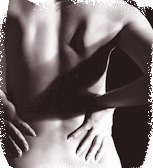 Back pain affects four out of five
Americans at some point in their life. It is an ailment that leads to many hours lost from
work and high medical treatment costs. According to the National Institute for
Occupational Safety and Health, back pain is one of the most common work-related health
problems. Back pain affects four out of five
Americans at some point in their life. It is an ailment that leads to many hours lost from
work and high medical treatment costs. According to the National Institute for
Occupational Safety and Health, back pain is one of the most common work-related health
problems.Back pain affects so many people because there are so many ways you can affect your back. If you are obese, physically unfit, do heavy labor or sit or stand for long periods of time, you are at risk for back pain. Participation in sports can mean back sprains or ligament or muscle tears, commonly occur. Stress may cause increased back muscle tension or spasms. Back pain may also relate to a joint problem such as arthritis, or other conditions such as kidney disease, pregnancy, heart disease or cancer. Often back pain is confined to the lower back, although it may extend into one or both legs. Your back may feel tender or sore and the pain may get worse with movement. You may experience back pain as a sharp or burning pain, or a dull ache. Back pain can range from a mild annoyance to a disabling condition. Most back pain will go away by itself, usually within two weeks when accompanied by simple, conventional and complementary therapies. Over-the-counter pain relievers, such as aspirin and ibuprofen, are conventional remedies that may help. These medicines can reduce inflammation in muscles and joints. Be sure to check with your doctor if you're taking any other medications for health problems. Note: You should call your doctor right away if the pain began after a fall or blow to the back. Also call your doctor if your back pain is accompanied by weakness or numbness in a leg or associated with a new bladder or bowel problem. For complementary therapies, you may wish to try bed rest at first. However, don't stay in bed more than a day or two. You risk reducing muscle strength and making the condition worse. To sooth sore and painful muscles, you can use cold and hot compresses (cold at first, then switching to hot after 24 hours). As soon as you are able, begin to move around. Get some fresh air, gentle exercise and sunshine: keep in mind that stress and inactivity can make back pain worse. Avoid strenuous or repetitive activities. Another complementary therapy you may want to try is acupuncture. Acupuncture has been used as a treatment for lower back pain for at least 100 years. In 1997, a National Institutes of Health panel of scientists, researchers and practitioners found acupuncture useful for lower back pain. They found that for some people acupuncture provided complete pain relief, lowered the need for pain medication or allowed more vigorous physical therapy. Another technique that appears to relieve back pain is called percutaneous electrical nerve stimulation, or PENS. This therapy is similar to acupuncture. It involves thin needles that are placed on the back. An electrical current is then sent through these needles to stimulate the nerves. PENS may help back pain sufferers have less pain, less need for medications, better sleep and the ability to engage in more physical activity. Massage and a therapy called the Alexander technique may also help people who have back pain. The Alexander technique increases awareness of poor posture habits and teaches you how to replace them with better ones. Addressing back troubles with this technique can be effective but may require patience; years of poor posture habits may take awhile to undo. Stress reduction therapies can reduce back pain as well. Yoga is effective for not only reducing stress but also strengthening back muscles as well as abdominal muscles, which lend support to your back. Other relaxation techniques can also help reduce stress. You'll find that most back pain will improve without surgery. If a doctor recommends back surgery, be sure to get a second opinion before you undergo this major procedure. |